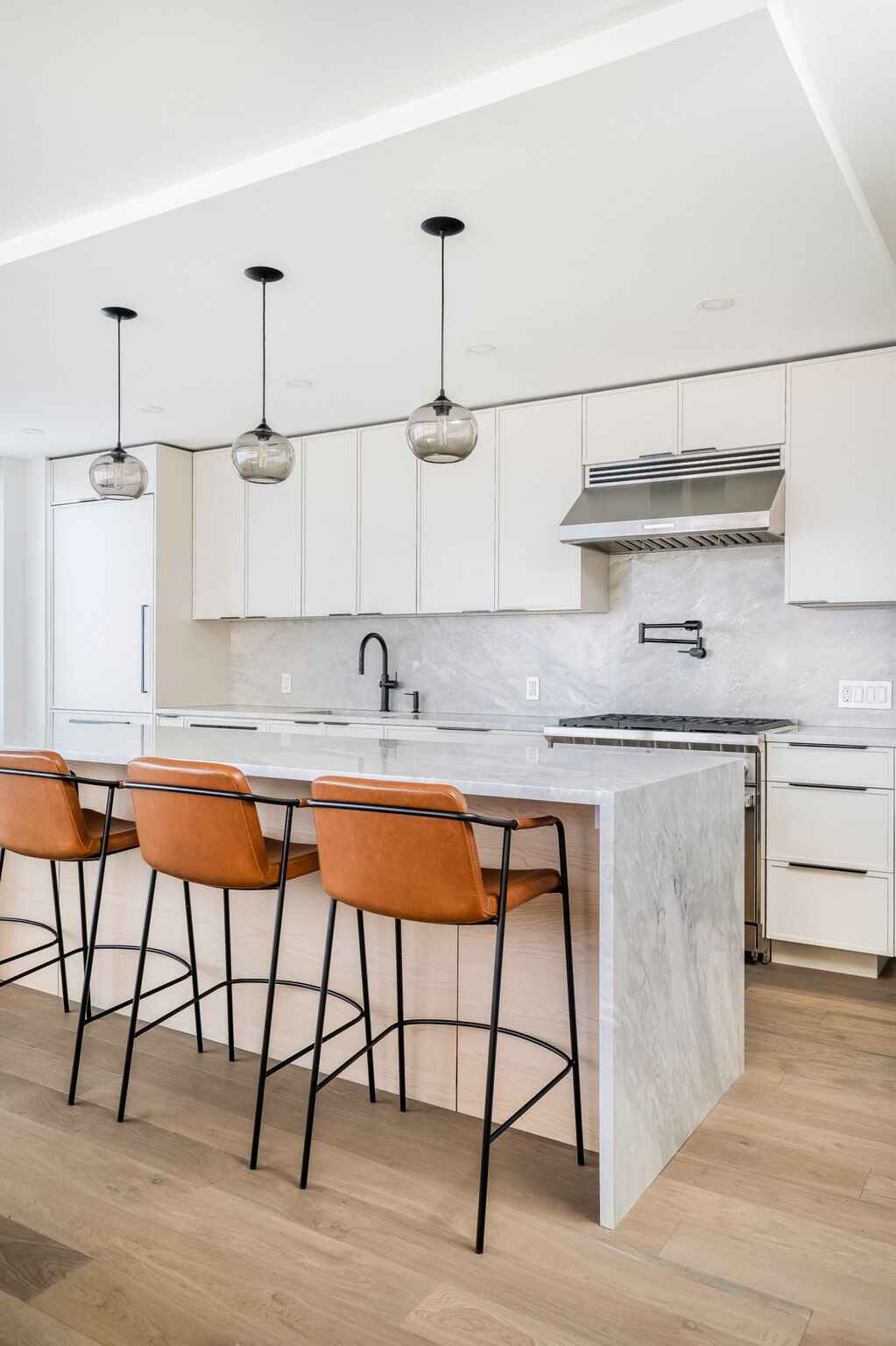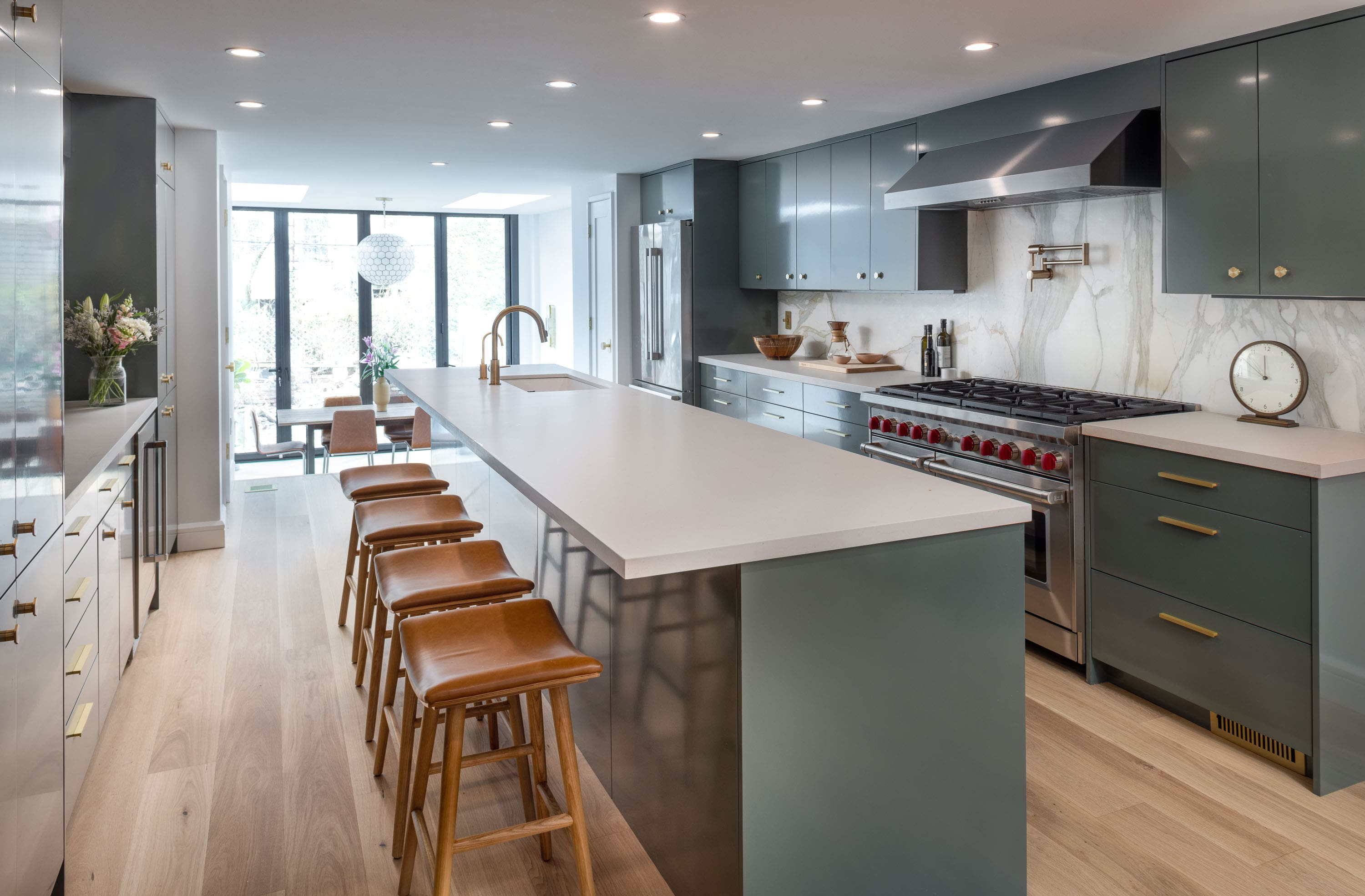Custom Layout Design For NYC Apartments: Maximizing Aesthetic And Function
Custom NYC apartment layout design can transform cramped pre-war co-ops and post-war condos into functional, modern homes that reflect how you actually live.
November 7, 2025
|
-min.jpg)
Custom Layout Design For NYC Apartments: Maximizing Aesthetic And Function
From pre-war co-ops with odd corners to post-war condos with narrow kitchens and too few bedrooms, most NYC apartments need custom layout design before they truly feel like home.
TABLE OF CONTENTS
- Understanding NYC Apartment Layout Challenges
- The Foundation Of Great Layout Design: Space Planning Principles
- Maximizing Square Footage Through Smart Layout Strategies
- Working With Design Professionals: Layout Planning Process
Anyone who’s ever entered the buyer’s market in NYC has walked through plenty of properties that had charm and checked many of their boxes, but ultimately the layout simply didn’t accommodate their vision. Whether the kitchen was too small and narrow or there are not enough bedrooms or bathrooms, many New York City apartments provide challenges for buyers looking to find their forever home.
While limited square footage and awkward architectural details may complicate your ideal home flow, challenges become opportunities with custom layout design. While reorganizing the schematics of your home’s square footage seems daunting, working with a renovation partner who can transform cramped spaces into functional, beautiful homes is more realistic than you may think. By partnering with a renovation firm who understands the layered nature of structural changes in NYC homes (especially a co-op) and can help accommodate the space to your liking - while also taking on the hassle of any associated red tape restrictions, you can create a home that balances aesthetics with practical living needs for modern standards. Your standards.
In effort to prevent potential buyers and current homeowners from settling for a layout that doesn’t meet their needs, this article explains layout principles, space optimization strategies, and design solutions specific to NYC apartments, all in effort to help you imagine a home that makes sense, while finding a way to achieve that vision.
.jpg)
[#1]Understanding NYC Apartment Layout Challenges[#1]
Whether we’re talking a pre-war co-op’s with narrow maids quarters or a post-war condo with low ceilings and cookie-cutter proportions, the city’s storied real estate stock was rarely designed with modern living in mind. Many apartments sacrifice storage for symmetry, separate spaces that could be connected, or rely on outdated room configurations that don’t feel appropriate for how people actually interact.
Gas & Electric Challenges
Before exploring design concepts and potential layout options for your apartment, it’s essential to first understand the constraints that will determine what’s feasible. In New York City, the most common limiting factors are the type and location of gas meters and the available electrical amperage within the property.
For instance, if your building has a dedicated gas meter located in the basement, relocating a gas range is typically limited to within about four feet of its existing position. Conversely, if the apartment has adequate electrical capacity, switching to an electric or induction range may offer far greater flexibility. Apartments with shared gas meters or meters located inside the unit also tend to allow more freedom in repositioning gas appliances.
Understanding these technical parameters—and how they affect both design feasibility and project cost—is the first and most critical step before diving into layout planning. These factors set the framework for what’s possible, ensuring that your design aspirations align with practical and regulatory realities.
Common Spatial Constraints In NYC Homes
From long, narrow rooms that restrict furniture placement to awkward alcoves and wasted transitional areas, inefficient layouts are one of the most common frustrations for city homeowners. Limited closet space, cramped kitchens, and inconsistent natural light further complicate functionality, forcing residents to make tradeoffs between beauty and practicality.
Pre-War Charm vs. Post-War Efficiency
In pre-war buildings, architectural character comes hand-in-hand with complexity. Think thick structural walls, compartmentalized layouts, and dated plumbing or electrical systems that make reconfiguration challenging.
On the other hand, post-war buildings may offer more modern aesthetics and open floor plans, they can feel rigid, with structural columns and mechanical runs dictating where changes can be made.
Navigating Structural And Regulatory Boundaries
Beyond design challenges, there are often built-in formalities that hinder potential renovations with layout reconfigurations as well. Co-op boards, building management, and the Department of Buildings all influence what’s possible in a renovation. Load-bearing walls, riser locations, and Landmark requirements set boundaries for movement and modification. The key is working with a renovation team that understands these systems intimately and can develop creative, compliant solutions that achieve the same design intent within those parameters.
Defining Function In Tight Or Open Spaces
Whether you’re designing a tight 550-square-foot studio or a 2,200-square-foot loft with endless open area, layout design is about creating space with purpose. Without clear boundaries and thoughtful flow, small spaces can feel cramped, and large ones can feel empty. Strategic use of millwork, lighting, and subtle architectural divisions can define zones for dining, entertaining, and downtime, all without wasting valuable square footage.
-min.JPG)
[#2]The Foundation Of Great Layout Design: Space Planning Principles[#2]
In New York City, where every square foot can cost thousands of dollars, space planning needs to be deliberate. When working with Gallery for a renovation that revolves around custom layout design, our team works with clients to identify how they plan to actually move, live, and interact within their home. That way, our custom apartment floor plans are designed with intent in mind and not just for aesthetics.
Understanding Flow And Function
The first principle of strong space planning is flow, the way people move naturally through a home. Hallways, entrances, and transitions between rooms should feel intuitive rather than forced. In NYC apartments, layouts are tight, so considerate circulation keeps a home open and balanced, without unnecessary barriers between rooms. The goal should be less hip bruises from running into countertops and more paths of least resistance.
See how the completely reconfigured floorplan from our co-op loft renovation in Tribeca at 335 Greenwich St allowed the open floor plan to feel less cluttered and more intentional from almost every angle.
Zoning For Real Life
Every home benefits from defined zones for cooking, working, relaxing, and resting, even when those areas share the same footprint. Smart zoning allows a studio to feel like a one bedroom or an open living room to feel naturally divided for hosting guests or crashing solo on the couch. Zones can be created through situational layout design, multi-faceted bespoke cabinetry, or changes in material and texture that provide subtle separation without adding walls. In our full renovation of a pre-war co-op in Manhattan at 1035 5th Avenue, we used strategic cove lighting and ceiling accents to successfully separate the combined living area and dining room.
Proportion And Scale
Proper proportion goes a long way. The size of each area and its relationship to others should dictate how the space is designed. Imbalanced room dimensions or poorly aligned zones can throw off the overall flow of a home. For instance, a tiny narrow kitchen alongside a massive dining room will immediately feel awkward. Same with a tiny island inside a spacious kitchen. Careful attention to proportion and scale, from ceiling height to wall placement, allows every area to feel intentional, balanced, and cohesive within your floor plan.
Read more about how functional design balance can be found within an extra large kitchen space via the before and after breakdown of our Manhattan condo renovation in The Chelsea Mercantile at 252 Seventh Ave, which can be seen below.
.jpg)
How People Actually Live
A layout only succeeds when the design supports your daily routine. When we’re planning custom NYC apartment floor plans with our clients, we always come prepared with questions based in reality, not just flare. Where do you drop your keys? How often do you cook? Does your office require peace and quiet? Designing with these daily habits in mind transforms a space from passable to personal.
See how we created a commercial-quality kitchen as part of our Manhattan apartment renovation at 91 Central Park West, specifically to accommodate our clients' penchant for constant cooking.
Storage At The Core Of Your Design
Within the most functional NYC apartment design, storage is part of the structure. Thoughtfully integrated storage can define how a space functions, keeping daily essentials accessible while maintaining a clean, open layout. After all, nothing absorbs square footage more than a bulky dresser or stand alone shelving unit. Custom cabinetry, wall niches, and built-ins allow storage to blend seamlessly into your design, freeing up valuable floor area and reducing clutter. View a variety of clever storage solutions we crafted into the kitchen of our Chelsea co-op renovation at 107 W 25th St.
- Discover More Options: The NYC Kitchen Accessories Guide: Smarter Storage, Sleeker Design
Designing For Flexibility
NYC apartments demand flexibility. A bedroom serving as a home office during the day may need to become a guest room at night, while a kitchen island that drives family meals can transform into a social hub when entertaining. Adaptable design gives homeowners freedom to transform their space on a whim. Features like sliding partitions, concealed storage, and flexible layouts allow rooms to shift purpose as needs change, keeping the home functional as needed.
See an example of flexible design within our Upper West Side condo renovation at 59 W 71st, where we created a hybrid office that subtly doubles as a guest bedroom, by creating a custom Murphy bed that can remain hidden until needed.
-min.jpg)
[#3]Maximizing Square Footage Through Smart Layout Strategies[#3]
While combining apartments in NYC is one way to maximize space in your apartment, those opportunities are few and far between. When sticking to your current square footage is the only option, the key to functional apartment design in NYC is learning how to make the most of what already exists. Through thoughtful planning and a few strategic design decisions, even compact apartments can feel larger, brighter, and more functional.
Creating The Illusion Of More Space
Strong layouts within congested apartments often rely on space maximization techniques most homeowners don’t consider. With forward-thinking design decisions like aligning the kitchen with the living area or positioning hallways to draw light inward, spaces have more room to breathe. Minimizing visual barriers and using consistent flooring or ceiling treatments can tie areas together, giving smaller apartments a more expansive feel without increasing their footprint. This was the core design goal of our Manhattan Apartment Renovation at 130 E 18th, where we moved the disconnected kitchen into the forefront of the main living area, creating an open floor plan apartment design that provides intentional flow and enhances both visual continuity and day-to-day functionality.
Using Height To Your Advantage
When floor space is limited, the smartest way to expand is upward. High ceilings, architectural beams, and integrated millwork all create a sense of heightened design. In luxury apartments, vertical design is a key feature, offering peak details like full-height cabinetry and statement lighting to draw the eye upward. In pre-war homes, maximizing wall height through tailored millwork and refined crown moulding can both offer function and added architectural allure. In our Manhattan loft renovation at 419 West 55th, we used full-height cabinetry in the centerpiece kitchen and leaned into the floor to ceiling pillar as a focal point of the open, vertical design.

Opening Up The Plan
Removing non-load-bearing walls is maybe the most common way to transform a cramped apartment. Knocking down barriers between the kitchen, dining, and living areas not only improves natural light flow but also encourages multi-zone use. The key to open floor plan apartment design is working with a partner who can identify which walls are load-bearing and which are not, offering a design plan that can accommodate in either scenario. In our Lincoln Square condo renovation in The Coronado at 155 West 70th Street - seen above, we tore down non-load bearing walls surrounding the former galley kitchen, unfolding the space significantly to create an open floor plan apartment design that allows for added flow and natural light to flourish.
Smarter Transitions With Sliding And Pocket Doors
In apartments where swing doors absorb valuable square footage, sliding and pocket doors provide sleek design and added flexibility. In common transitional spaces like small bedrooms, home offices, or en suite bathrooms, pocket doors allow rooms to connect or close off as needed. In many cases, they can be designed so discretely they disappear entirely into the wall, maintaining visual continuity while expanding functional flow. Pocket doors were used to conserve space throughout our Sutton Place co-op renovation in The Sovereign at 425 East 58th Street, ranging from the den to the bathroom. See the pocket doors in action below as Avi walks viewers through the space in our pre-renovation walk-through video.
Making Awkward Spaces Work Harder
NYC apartments are famous for narrow hallways, alcoves, and curious corners that rarely add functional design value. Thankfully, strategic millwork or built-ins can turn these underused pockets into valuable storage niches. This could mean cabinetry under staircases, custom benches with drawers, or recessed shelving in thick pre-war walls. With considerate apartment design optimization, no space is wasted.

[#4]Working With Design Professionals: Layout Planning Process[#4]
Bringing a custom NYC apartment layout design to life requires equal amounts of process and vision. While you may have ideas on how to maximize your square footage, the reality is making the most of your space requires collaboration between homeowners who know how they want to live and design-build professionals who know how to make their vision possible. The goal is to translate your routine, needs, and style preferences into a floor plan that feels both intentional and effortless.
A Collaborative Design Process
At Gallery, the layout planning process starts with discovery. Together with each client, we map out how they ideally plan on using their home, asking questions that range from how they cook to entertain to the ways they unwind and store daily essentials. This personal insight forms the foundation for our apartment design optimization. From there, our internal architects and interior designers work side by side to develop a plan that balances lifestyle with function, turning conceptual ideas into a tangible design that accommodates the realities of their NYC building.
Detailed Space Planning and Visualization
The beauty of a well-planned layout comes as a result of precise planning and proper expectation setting. Our 3D renderings allow homeowners to see exactly how space, light, and flow will interact before construction even begins. These life-like visuals eliminate guesswork, allowing every doorway, sightline, and built-in feels considered. Clients can visualize their updated NYC apartment layout design virtually, providing feedback that refines their vision before the first wall is touched.
- Learn More: Render To Reality: How Our Rendering Process Helps Clients Visualize Their NYC Renovation
The Design-Build Advantage
Unlike a traditional renovation model where design and construction operate independently, a design-build approach integrates both specialties under one roof. This alignment creates accountability, efficiency, and consistency from the moment you close on your new apartment to the day you take the permit paperwork off your door. The same team that designs the floor plan is responsible for executing the renovation, meaning decisions about structure, materials, and timelines are made cohesively and without disconnect between design intent and on-site reality.
- Compare Further: Design-Build Vs General Contractor: What’s The Difference?
Timelines, Budgets, And Real-World Challenges
Custom NYC apartment layout design demands careful planning, especially when balancing creativity with compliance. Load-bearing walls, riser locations, and co-op or condo board approvals often shape what’s possible. At Gallery, we anticipates these variables early, managing Department of Buildings filings and approvals in parallel with design development to keep the project on track. Transparent budgeting and phased scheduling allow our clients to see where every dollar and day is allocated from day one, removing surprises before they happen.
- Further Consideration: 5 Most Asked Questions When Considering A Design-Build Firm In NYC
Wrapping Up
Whether you’re reimagining a compact pre-war apartment or transforming a sprawling loft with industrial bones, thoughtful NYC apartment layout design turns architectural limitations into creative opportunities. With support from an experienced renovation partner, the same walls that once felt restrictive can become the framework for your future dream home.
At Gallery, we specialize in helping New Yorkers see what’s possible within their current square footage. From reconfiguring entire floor plans to refining subtle spatial details, our full-service design-build approach brings cohesion, clarity, and craftsmanship to every inch of your home.
Considering a renovation in NYC that may require significant apartment layout design optimization? Explore more inspiration and expert insights around layout design, apartment floor planning, and interior design by visiting our Design & Reno blog or viewing our full project portfolio to see how we’ve helped homeowners across Manhattan and Brooklyn reimagine their space with intent. Or, if you’re ready for a design consultation, contact us and allow Gallery to bring your vision to life.

.png)
.png)



.png)

.jpg)

%20(2).jpg)


.jpg)
%20Gallery%20KBNY.JPG)


